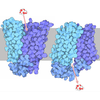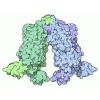+ Open data
Open data
- Basic information
Basic information
| Entry |  | |||||||||
|---|---|---|---|---|---|---|---|---|---|---|
| Title | CryoEM structure of osPHT1-11 at pH 8.0 | |||||||||
 Map data Map data | ||||||||||
 Sample Sample |
| |||||||||
 Keywords Keywords | phosphorus / rice / uptake / TRANSPORT PROTEIN | |||||||||
| Function / homology |  Function and homology information Function and homology informationphosphate transmembrane transporter activity / phosphate ion transport / symporter activity / membrane Similarity search - Function | |||||||||
| Biological species |  | |||||||||
| Method | single particle reconstruction / cryo EM / Resolution: 3.3 Å | |||||||||
 Authors Authors | Du ZM / Guan ZY / Liu Z | |||||||||
| Funding support |  China, 1 items China, 1 items
| |||||||||
 Citation Citation |  Journal: Dev Cell / Year: 2025 Journal: Dev Cell / Year: 2025Title: Cryo-EM structure and dynamic basis of phosphate uptake by PHT1 in rice. Authors: Zhangmeng Du / Zeyuan Guan / Hai Liu / Jie Zhang / Haitao He / Zhiwen Zheng / Wenhui Zhang / Lihuan Jiang / Jiaqi Zuo / Yan Liu / Beijing Wan / Haifu Tu / Faming Dong / Xuelei Lai / Lizhong ...Authors: Zhangmeng Du / Zeyuan Guan / Hai Liu / Jie Zhang / Haitao He / Zhiwen Zheng / Wenhui Zhang / Lihuan Jiang / Jiaqi Zuo / Yan Liu / Beijing Wan / Haifu Tu / Faming Dong / Xuelei Lai / Lizhong Xiong / Ping Yin / Shaowu Xue / Yanke Chen / Zhu Liu /  Abstract: Phosphorus is an essential macronutrient for plants, primarily absorbed from the soil as inorganic phosphate (Pi) through root-located Pi transporters. Despite decades of research into these ...Phosphorus is an essential macronutrient for plants, primarily absorbed from the soil as inorganic phosphate (Pi) through root-located Pi transporters. Despite decades of research into these transporters as targets for developing Pi-efficient crops, their mechanisms for Pi import remain poorly understood. Here, we present the cryo-electron microscopy (cryo-EM) structures of the rice Pi importer OsPHT1;11 in both Pi-bound and unbound forms, characterize its conformational dynamics, and demonstrate how these dynamics contribute to its transport function. Pi is recognized through conserved residues found in plants, with its translocation facilitated by a typical alternating-access mechanism. Single-molecule fluorescence resonance energy transfer (smFRET) analyses show that this transporter undergoes dynamic conformational fluctuations, which are differentially linked to its Pi transport capability, with a predominance of extracellular open conformations favoring Pi transport, while more populated intracellular open conformations hinder it. These findings highlight key conformational determinants of transport activity and provide mechanistic insights into Pi uptake in plants. | |||||||||
| History |
|
- Structure visualization
Structure visualization
| Supplemental images |
|---|
- Downloads & links
Downloads & links
-EMDB archive
| Map data |  emd_62441.map.gz emd_62441.map.gz | 78.9 MB |  EMDB map data format EMDB map data format | |
|---|---|---|---|---|
| Header (meta data) |  emd-62441-v30.xml emd-62441-v30.xml emd-62441.xml emd-62441.xml | 14.6 KB 14.6 KB | Display Display |  EMDB header EMDB header |
| Images |  emd_62441.png emd_62441.png | 62.7 KB | ||
| Filedesc metadata |  emd-62441.cif.gz emd-62441.cif.gz | 5.7 KB | ||
| Others |  emd_62441_half_map_1.map.gz emd_62441_half_map_1.map.gz emd_62441_half_map_2.map.gz emd_62441_half_map_2.map.gz | 77.6 MB 77.6 MB | ||
| Archive directory |  http://ftp.pdbj.org/pub/emdb/structures/EMD-62441 http://ftp.pdbj.org/pub/emdb/structures/EMD-62441 ftp://ftp.pdbj.org/pub/emdb/structures/EMD-62441 ftp://ftp.pdbj.org/pub/emdb/structures/EMD-62441 | HTTPS FTP |
-Validation report
| Summary document |  emd_62441_validation.pdf.gz emd_62441_validation.pdf.gz | 779.1 KB | Display |  EMDB validaton report EMDB validaton report |
|---|---|---|---|---|
| Full document |  emd_62441_full_validation.pdf.gz emd_62441_full_validation.pdf.gz | 778.7 KB | Display | |
| Data in XML |  emd_62441_validation.xml.gz emd_62441_validation.xml.gz | 12.9 KB | Display | |
| Data in CIF |  emd_62441_validation.cif.gz emd_62441_validation.cif.gz | 15.3 KB | Display | |
| Arichive directory |  https://ftp.pdbj.org/pub/emdb/validation_reports/EMD-62441 https://ftp.pdbj.org/pub/emdb/validation_reports/EMD-62441 ftp://ftp.pdbj.org/pub/emdb/validation_reports/EMD-62441 ftp://ftp.pdbj.org/pub/emdb/validation_reports/EMD-62441 | HTTPS FTP |
-Related structure data
| Related structure data |  9kmqMC  9kouC M: atomic model generated by this map C: citing same article ( |
|---|---|
| Similar structure data | Similarity search - Function & homology  F&H Search F&H Search |
- Links
Links
| EMDB pages |  EMDB (EBI/PDBe) / EMDB (EBI/PDBe) /  EMDataResource EMDataResource |
|---|---|
| Related items in Molecule of the Month |
- Map
Map
| File |  Download / File: emd_62441.map.gz / Format: CCP4 / Size: 83.7 MB / Type: IMAGE STORED AS FLOATING POINT NUMBER (4 BYTES) Download / File: emd_62441.map.gz / Format: CCP4 / Size: 83.7 MB / Type: IMAGE STORED AS FLOATING POINT NUMBER (4 BYTES) | ||||||||||||||||||||||||||||||||||||
|---|---|---|---|---|---|---|---|---|---|---|---|---|---|---|---|---|---|---|---|---|---|---|---|---|---|---|---|---|---|---|---|---|---|---|---|---|---|
| Projections & slices | Image control
Images are generated by Spider. | ||||||||||||||||||||||||||||||||||||
| Voxel size | X=Y=Z: 1.08 Å | ||||||||||||||||||||||||||||||||||||
| Density |
| ||||||||||||||||||||||||||||||||||||
| Symmetry | Space group: 1 | ||||||||||||||||||||||||||||||||||||
| Details | EMDB XML:
|
-Supplemental data
-Half map: #2
| File | emd_62441_half_map_1.map | ||||||||||||
|---|---|---|---|---|---|---|---|---|---|---|---|---|---|
| Projections & Slices |
| ||||||||||||
| Density Histograms |
-Half map: #1
| File | emd_62441_half_map_2.map | ||||||||||||
|---|---|---|---|---|---|---|---|---|---|---|---|---|---|
| Projections & Slices |
| ||||||||||||
| Density Histograms |
- Sample components
Sample components
-Entire : osPHT1-11
| Entire | Name: osPHT1-11 |
|---|---|
| Components |
|
-Supramolecule #1: osPHT1-11
| Supramolecule | Name: osPHT1-11 / type: complex / ID: 1 / Parent: 0 / Macromolecule list: all |
|---|---|
| Source (natural) | Organism:  |
-Macromolecule #1: Inorganic phosphate transporter 1-11
| Macromolecule | Name: Inorganic phosphate transporter 1-11 / type: protein_or_peptide / ID: 1 / Number of copies: 2 / Enantiomer: LEVO |
|---|---|
| Source (natural) | Organism:  |
| Molecular weight | Theoretical: 63.575168 KDa |
| Recombinant expression | Organism:  Homo sapiens (human) Homo sapiens (human) |
| Sequence | String: MDYKDDDDKG DYKDDDDKID YKDDDDKGSM ADADGGSNLA VLDALDSART QMYHMKAIVI AGMGFFTDAY DLFCISTVSK LLGRLYYQP DGSTDSKPGA LSKTANNMVI GVALVGTLMG QLVFGYFGDK LGRKRVYGVT LILMAACAIG SGLSFGSSRK A VIGTLCFF ...String: MDYKDDDDKG DYKDDDDKID YKDDDDKGSM ADADGGSNLA VLDALDSART QMYHMKAIVI AGMGFFTDAY DLFCISTVSK LLGRLYYQP DGSTDSKPGA LSKTANNMVI GVALVGTLMG QLVFGYFGDK LGRKRVYGVT LILMAACAIG SGLSFGSSRK A VIGTLCFF RFWLGFGIGG DYPLSATIMS EYSNKKTRGA FIAAVFAMQG VGIIFAGLVS MIVSSIFLTY NKAPSYKGNH DL SRQMPAA DYVWRIVLMI GAFPALATFY WRMKMPETAR YTAIIDGNAK QAANDMQKVL SIEIEAEQEK LAKFNAANNY PLL SMEFAR RHGLHLIGTT TTWFLLDIAF YSQNLTQKDI FPAMGLISGA AEVNALTEMF QISKASFLVA LLGTFPGYWV TVAL IDKMG RYMIQLIGFF MMSMFMLAMG ILYDYLKTHH FLFGLLYALT FFFANFGPNS TTFVLPAELF PTRVRSTCHA ISAAA GKAG AIVAAFGIQK LTYNSQVKSI KKALIILSIT NMLGFFFTFL VPETMGRSLE EISGEDGNTG AGGGGAPAAA NAGVGV SAS DVSRDEKFPA SSTEWQTSMH A UniProtKB: Inorganic phosphate transporter 1-11 |
-Experimental details
-Structure determination
| Method | cryo EM |
|---|---|
 Processing Processing | single particle reconstruction |
| Aggregation state | particle |
- Sample preparation
Sample preparation
| Buffer | pH: 8 |
|---|---|
| Vitrification | Cryogen name: ETHANE |
- Electron microscopy
Electron microscopy
| Microscope | TFS KRIOS |
|---|---|
| Image recording | Film or detector model: GATAN K3 BIOQUANTUM (6k x 4k) / Average electron dose: 50.0 e/Å2 |
| Electron beam | Acceleration voltage: 300 kV / Electron source:  FIELD EMISSION GUN FIELD EMISSION GUN |
| Electron optics | Illumination mode: FLOOD BEAM / Imaging mode: BRIGHT FIELD / Nominal defocus max: 2.0 µm / Nominal defocus min: 1.2 µm |
| Experimental equipment |  Model: Titan Krios / Image courtesy: FEI Company |
 Movie
Movie Controller
Controller








 Z (Sec.)
Z (Sec.) Y (Row.)
Y (Row.) X (Col.)
X (Col.)




































